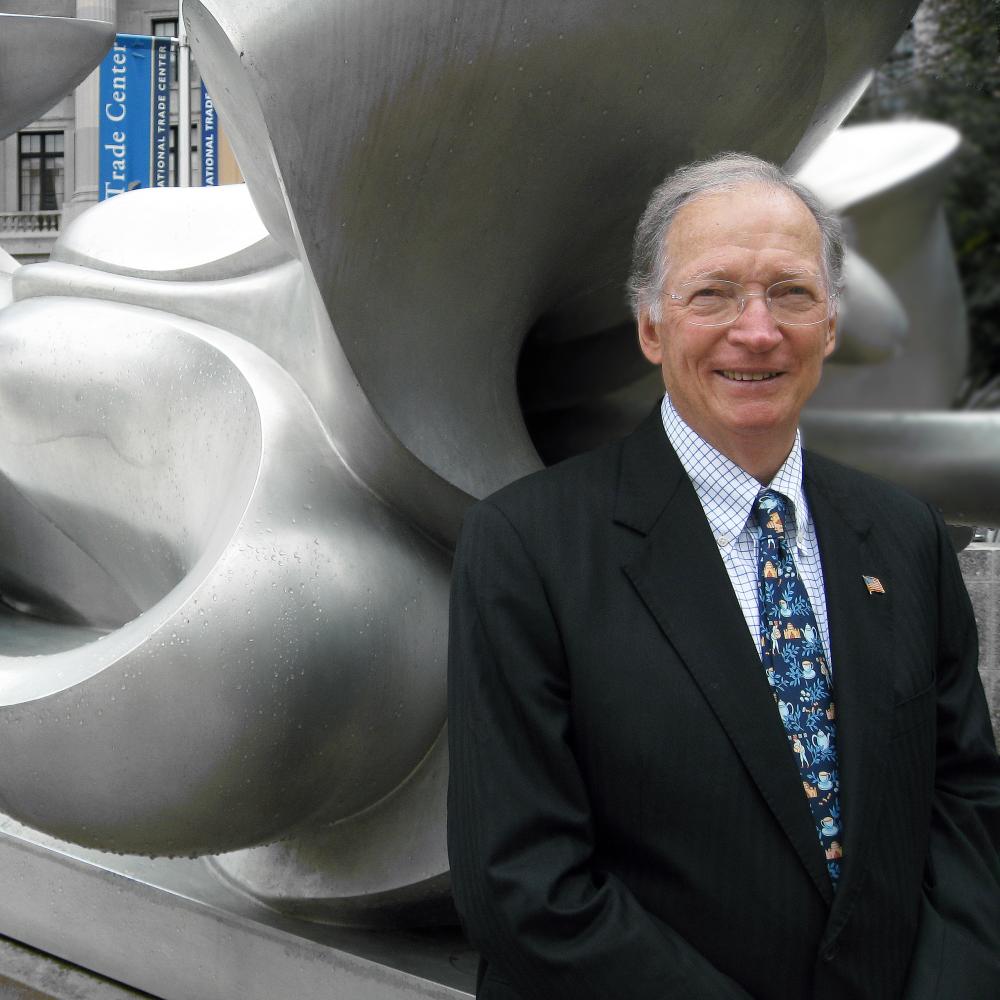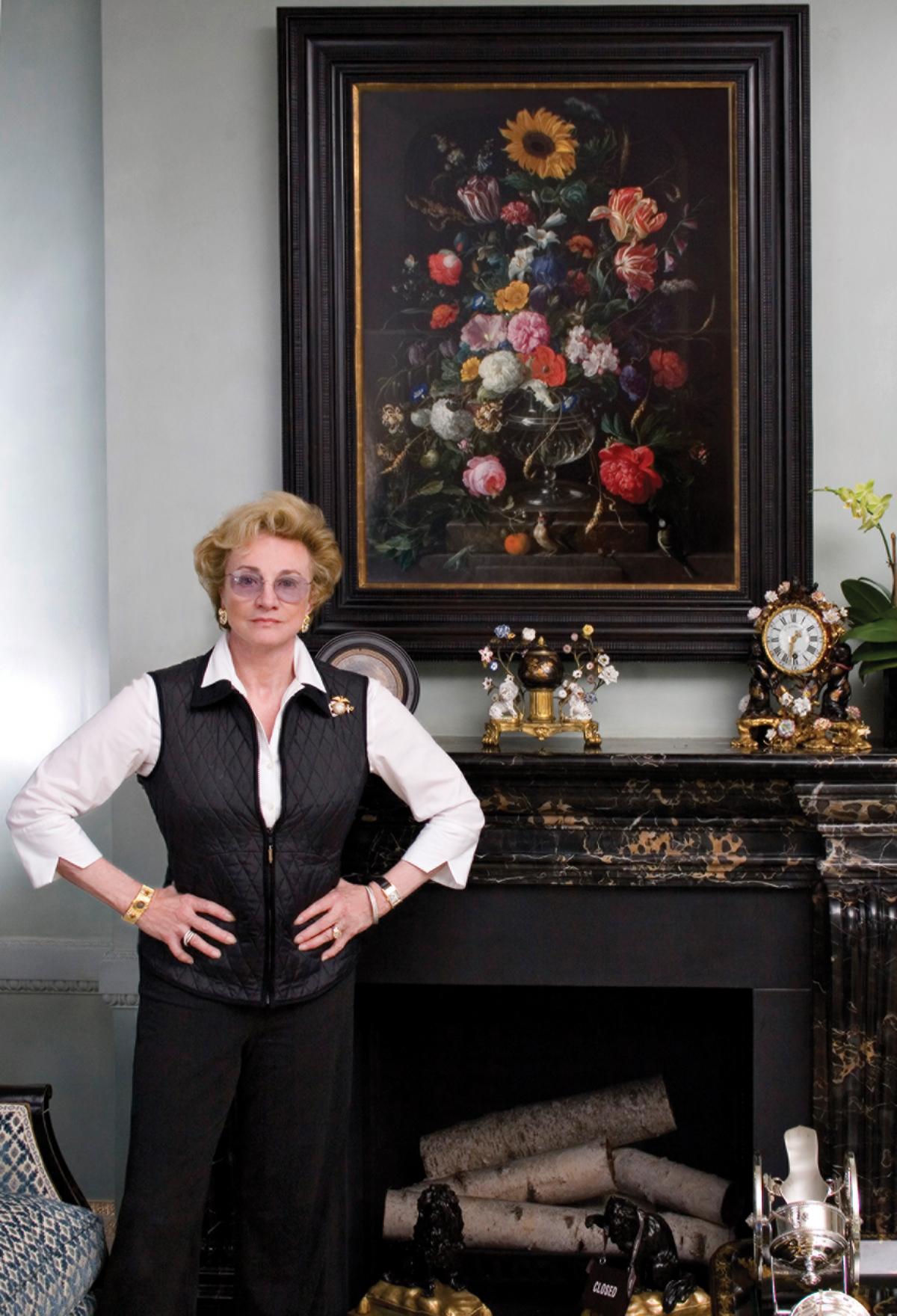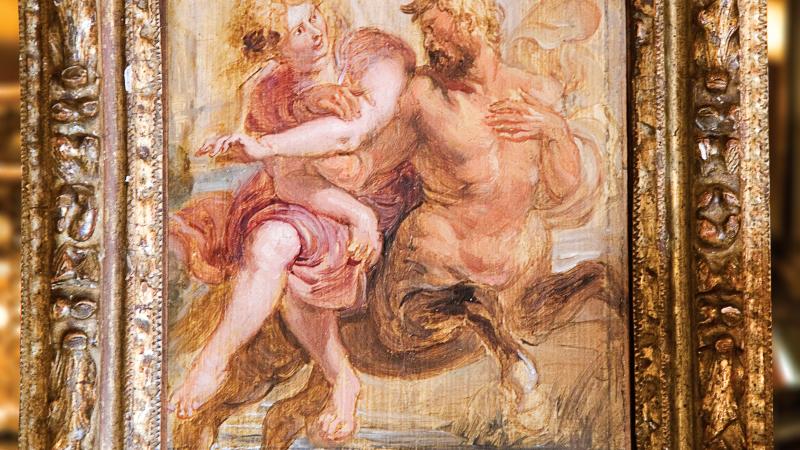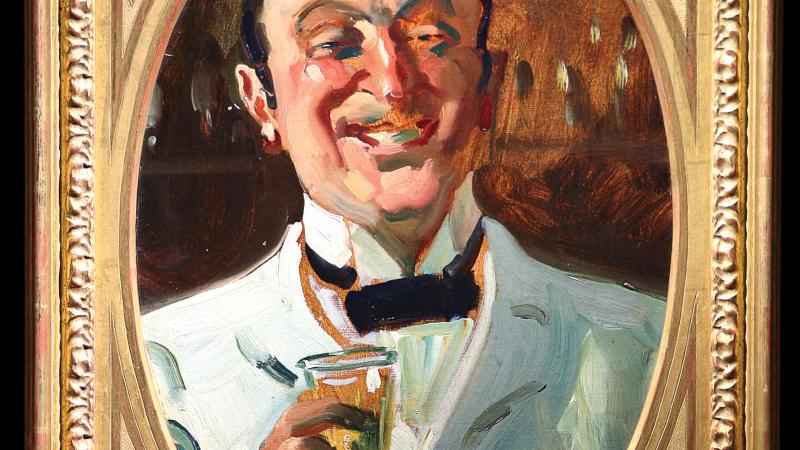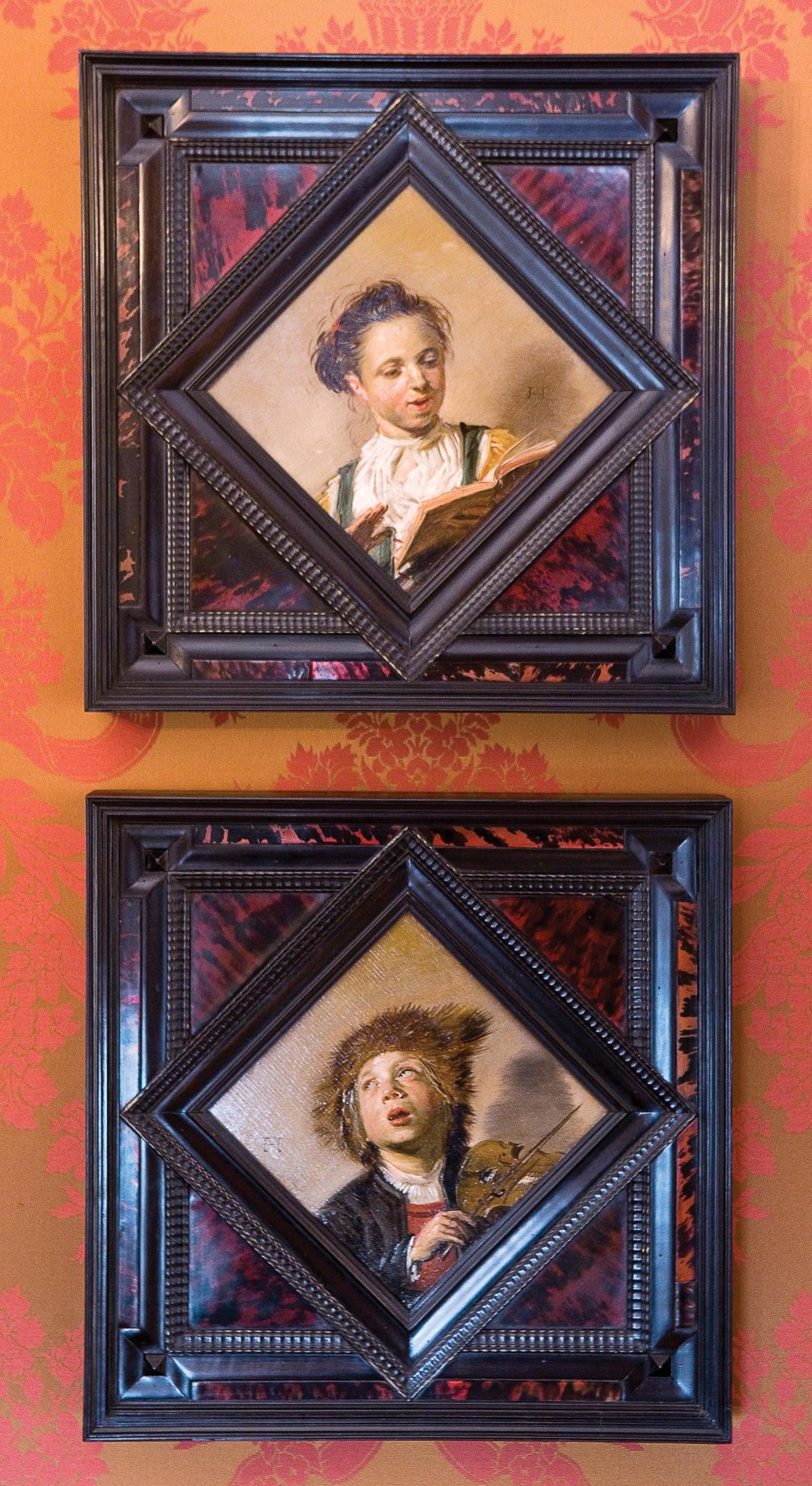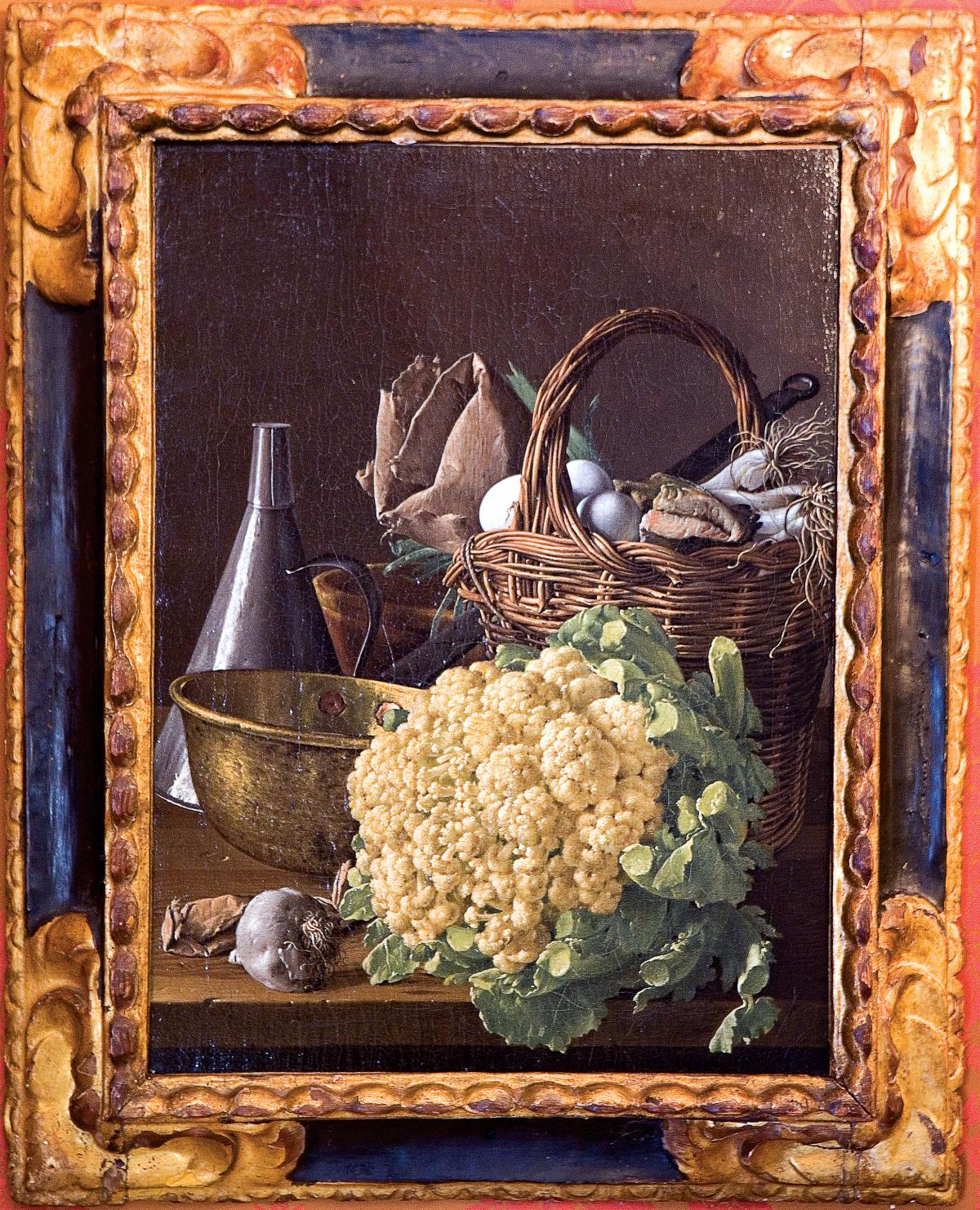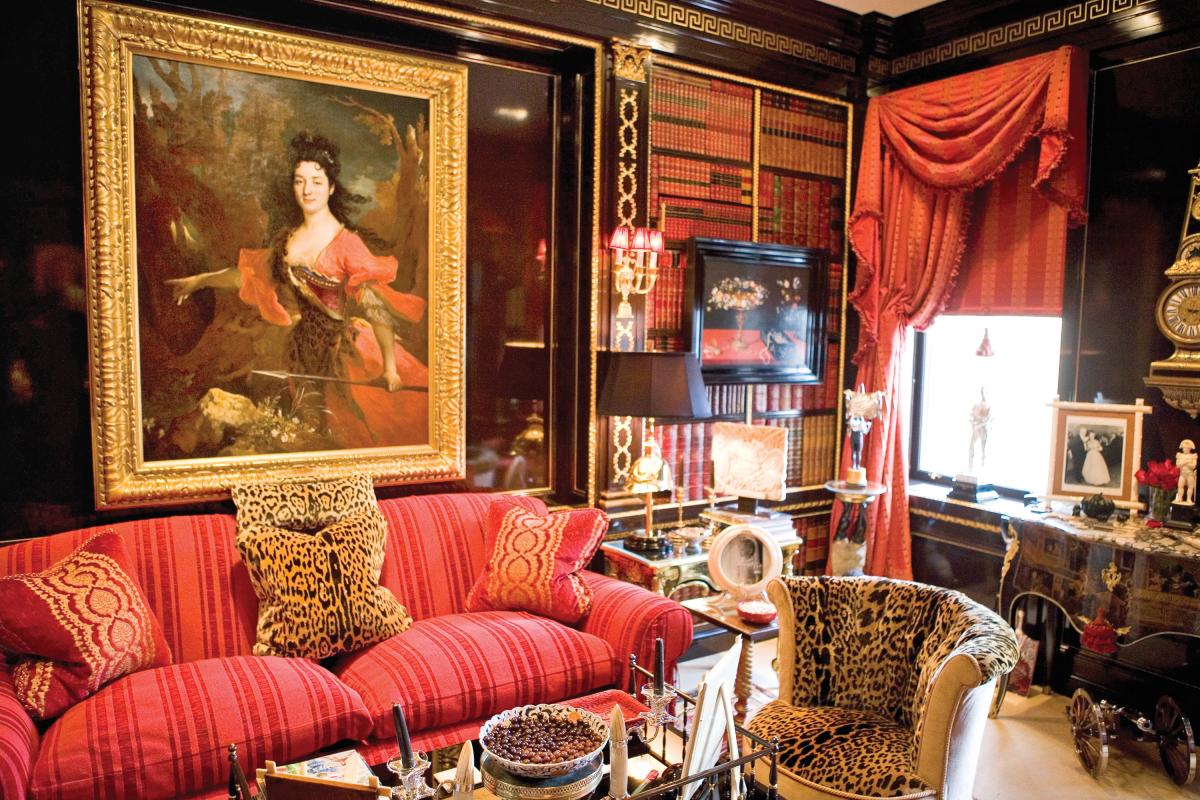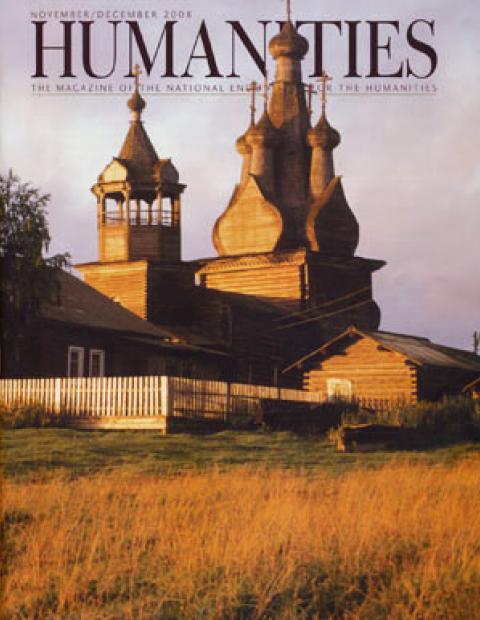Meet the Saunderses, philanthropic champions of such diverse institutions as the Marine Corps University and the New-York Historical Society. They met in 1961. Thomas, a VMI graduate and an Army veteran, was thinking about business school when he met Jordan, the daughter of Major General Matthew C. Horner. After Tom graduated from the Darden School of Business at the University of Virginia, the couple moved to New York, where Tom began a hugely successful career on Wall Street, working for Morgan Stanley. He became a pioneer in capital markets and handled the underwriting for British privatization under Margaret Thatcher. After Morgan Stanley went public in 1986, Tom and Jordan established the Ivor Foundation to coordinate their private philanthropy, which would help inspire, and transform, a host of important educational and cultural institutions.
NEH CHAIRMAN BRUCE COLE: I would like us to talk about your background, your philanthropy, and your great passions, American history and art. Let’s start with where you were born, Ivor. Is it pronounced Eye-vor?
THOMAS SAUNDERS: Correct! Ivor is a small town, maybe three hundred people in southside Virginia, in Southampton County, and my family was from that area. The earliest arrivals got off of the boat near Jamestown around 1620, went south of the James and settled in Isle of Wight County. My grandfather moved his timber business to Southampton County in the latter part of the nineteenth century.
This October Ivor is celebrating the one-hundredth anniversary of its incorporation. And I will be there as the grand master of a parade, which may have only thirty people in it. My grandfather signed the papers of incorporation in this little town. There are going to be hot dogs, hamburgers, fried chicken, and high school bands, and it is really America in its probably grandest presentation. We are going to take our grandchildren and go spend the day, walking around and talking to members of families that we have lost contact with over the years. I’m really looking forward to going home.
COLE: Do you have any relatives still there?
SAUNDERS: My father passed away years ago and most of his immediate family in the area has died. The others have left, for Richmond or Norfolk, where I grew up. My mom, who has also passed away, was a schoolteacher. She taught me twice in the lower grades. They were the toughest years of my life.
COLE: I bet!
SAUNDERS: I could never say to her, ‘No, Mom, I’ve got no homework tonight.’ Then I went to VMI and studied electrical engineering. Everyone from VMI went into the service, so I went into the Army. I did my tour of duty in the infantry and finished up in the Army reserves. I was fortunate. This was between the Korean War and Vietnam, but I was very proud of my military service.
I worked in engineering but was thinking of going back to business school. Then, out of the blue, I got something in the mail that said, ‘you’ve been selected for the James Wheat Scholarship.’ This was named for Jim Wheat from Richmond, Virginia, a great VMI man. His father started an investment banking firm in Richmond; Jim built it into a regional powerhouse. So, he gave a scholarship, and I got lucky and got it. I went to the University of Virginia Darden School of Business. There I became very interested in finance, and I decided I would take a shot at Wall Street. I went to New York City for interviews with some of the firms you would recognize, Goldman Sachs and Morgan Stanley, Lehman Brothers. I loved two firms in particular, Goldman Sachs and Morgan Stanley, and I got offers from both of them. They didn't make many offers to MBAs from the South, and at Morgan Stanley I may have been the first Southerner ever hired. It was a tiny firm then, two hundred people or so.
As you probably know, Morgan Stanley was created by the Glass-Steagall Act in 1933, which split commercial banking and investment banking. J.P. Morgan, the name of the firm at that time, split into the two firms, J.P. Morgan and Morgan Stanley. Henry Morgan and his partner Harold Stanley took the bank’s bond business and that became Morgan Stanley. The firm’s offices were at 2 Wall Street, in little offices, maybe three floors overlooking Trinity Church. Right down the street was the Morgan Bank, now called Morgan Guaranty. We’d eat in their lunch room, and if we needed medical treatment, we went to their dispensary. The firms were like cousins, situated a block apart, and very closely linked.
I started there in 1967, and over the next twenty years, Morgan Stanley morphed into the preeminent firm on Wall Street. A small group of us started to grow the capital market side of the business. We had a small trading room when I arrived. It was an internal trading room with one ticker tape and no computers. We had one trader who did equities, another who did fixed incomes. If you can believe it, that was the center of the firm’s capital markets business.
In those days, everyone started on the lowest rung, as a statistician.
COLE: What exactly did a statistician do?
SAUNDERS: A statistician today would be like an analyst. The statisticians prepared all the numbers, all the exhibits for partners. It was like serving in an apprenticeship.
COLE: Like starting in the mailroom.
SAUNDERS: Exactly. There was a black box. It wasn’t leather or anything, just a very pedestrian box that you carried all the stuff in. When a partner went to a meeting, the statistician carried everything for the meeting in that box.
COLE: I wonder if they still have it.
SAUNDERS: Probably. Now the black box is a computer. We, of course, had no computers. We had Friden calculators, which were mechanical. We had spreadsheets, which could be as big as this coffee table. Every single number on it had to be checked by another statistician.
We would go to great lengths to design the analytical exhibits. You had your source documents and, if you were comparing the financials for, say, an oil company, you would have a spreadsheet showing all of the oil companies: Standard Oil of New Jersey, Indiana, Texaco, Ohio, and so on. And you would have all the source documents, SEC filings, etcetera.
COLE: Today, of course, with high-speed computers and data mining, you can see so many different things.
SAUNDERS: Exactly right. Back then what you had was static, but it could be manipulated. The difference between using data then and now is manual labor. Today, when we do a model of a company, we can look at anything in any way we want to. All we have to do is input new assumptions. What if the growth rate is this? Or margins are this? Boom, it’s done.
John Young wanted the same information, but the button he pushed was us. He was a senior partner from Enid, Oklahoma, and his father was the last governor when Oklahoma was still a territory. And he had gone to VMI and to Harvard Business School when that was highly unusual.
He would say, ‘Mr. Saunders, do you think you could run this set of new assumptions?,’ and you had been there all night long, creating this thing. And now he is going to tweak it! So, then you had to go back down to the calculating room, redo the whole exhibit, and have someone come back with you and check every number. The Morgan partners would never accept an exhibit with unchecked numbers. Never.
COLE: Did your engineering background make a difference?
SAUNDERS: Probably as a way of thinking, a way of approaching issues. The people who migrate into engineering probably have a more analytical approach.
All statisticians, everyone at the firm, started in corporate finance. The firm basically did advisory work and public offerings, equity, and debt. We moved to 140 Broadway, and I went up into the syndicate side of the business, where all the public offerings were done. All the corporate and government offerings came across one desk: domestic and the early Eurobond-type financings, and so on. I also kept the capital position with Morgan Stanley. And in 1971, Morgan Stanley had $8 million of capital.
COLE: $8 million!
SAUNDERS: I kept the capital position on a yellow pad at my roll-top desk. Inheriting one of twelve desks at the firm was a special privilege. It had a button, from the old days, on it that said “Boy,” which the partners would push for the boy to come—deliver a package, bring water, whatever.
It was a different era. If you were headed out to a meeting but didn’t have a proper hat, Mr. Morgan wouldn’t let you go.
COLE: What a character.
SAUNDERS: To finish the story about the capital position, when we would do financing or underwriting, I had to calculate to see if we had enough capital on hand. If we didn’t, I would call over to the Morgan Bank and take a loan from Mr. Morgan’s personal line. Today it seems unbelievable.
COLE: What happened to this quaint little Wall Street you describe?
SAUNDERS: That’s the question! During the sixties, a group of young Turks came into Morgan Stanley, six or seven of us, maybe ten at the outside, by 1971 in our early thirties. The others had all gone to Harvard Business School, or Stanford, or Wharton. This group started to build, out of this little trading room, a bond trading business. This was the first step in building the firm’s capital markets business and the transformation of Morgan Stanley into the great global financial services firm of today. In other words, we tried to really grow our investment and fixed-income business. On the syndicate side, we were doing the most important underwriting in the world, bar none. We did all of the seven sisters, all of the Standard Oil companies. We did General Motors, we did General Electric, we did DuPont, we did IBM’s business. In most offerings, we were the sole managers. That means we ran the deals by ourselves. We had the finest book of business on earth. We had the Kingdom of Sweden, Great Britain’s financings, Mexico, the works. It was worldwide. We were opening up new markets in Saudi Arabia and other Middle East countries. With the Saudi Arabian Monetary Agency, we started doing the first big private placements. No one even knew they were being done. SAMA was writing $250 million-plus checks when people thought that was the moon. People couldn’t comprehend transactions that size.
On the international side, we had a joint partnership with J.P. Morgan, and there was a company in Paris called Morgan & Cie, which was a European bank we owned fifty-fifty. In the early seventies, we bought out J.P. Morgan, changed the name to Morgan Stanley International, and moved it to London to become the initial core of our international business. Some of the young Turks ran most of these businesses. Morgan Stanley was the classic investment bank—advisory business, mergers and acquisitions, and public offerings. That was the business for its first thirty-five to forty years.
COLE: When did Wall Street change?
SAUNDERS: From roughly 1974 to 1986. It morphed into a completely different world, in size and complexity, and it changed into a global business.
When we first started doing the Eurobond business, we would take a team of people from New York on the Queen Elizabeth. Lawyers from Davis Polk, Morgan Stanley’s team, and their wives, would take the boat to Southampton, England. They would draft the documents on a three- or four-day cruise, with dinners in the evening. That is how the business was done in the early seventies.
By 1983, I started working on the big privatizations for Margaret Thatcher, British Telecom, British Petroleum. In 1983, I think I flew to London twenty-five times on the Concorde. I mean, you would get a call from the British Treasury and they would say, ‘Tom, do you think you could pop over for a meeting on Tuesday?,’ and when you got home, they’d call and say, ‘Would you mind coming back?’ On Thursday, you’d go back. It was brutal.
COLE: A very impressive period of time.
SAUNDERS: You know something, I heard General Cody say the other day at West Point, “Technology changes, character and leadership do not.”
COLE: Yes, technology is only as good as the people who are using it.
SAUNDERS: The business was still driven by relationships, by your word, by integrity, by character; but what changed was all the technology. You just drove yourself into a competitive frenzy because you were up against Goldman and Salomon, and First Boston and Merrill, Dillon Read and Kuhn, Loeb, and everybody was good. You would go to a beauty contest, as we called them. In separate rooms would be all of your competitors waiting to go in. There would be thirty people from the Treasury in London, looking like the Supreme Court, and you would have to strut your stuff to get the underwriting, to do the British Telecom deal, which was the biggest and the single most important privatization done. The model is still used today. The stuff we did in that deal is the template used today. All the stuff that was developed in the seventies and early eighties is exactly how public offerings in this country are done today.
And the British merchant banks had a very different underwriting system, they didn't know how to do our offerings. The head of public financing at Cazenove was a great friend of ours named David Mayhew, and he said to me recently, “You taught me the public offering business. We didn’t know how to do it.” He’s a great banker and is being modest, but it was new to them. When we went to the Treasury Department of Her Majesty’s Government, they said, ‘You have to have these guys, these merchant bankers, in the room.’ They went to school on us.
COLE: Like so many really successful people that I have met, you also bring a passion to this. Let’s talk about your other passions. History, first. Did you have this sense of history growing up?
SAUNDERS: I don’t think so. Although in Virginia you lived it. Jordan’s family, by the way, has been in that part of Virginia just as long as my family has.
COLE: Did your families know each other?
MRS. SAUNDERS: Oh, yes. Because of the Second World War, people moved away and things changed. But this sense of the past is a very Southern thing. Southerners greet each other by their history. If I go home to Virginia, and we go to the club, someone will say, ‘Oh, there’s Jordan. You know, she’s married to Big Tom’s son. You remember, then they moved to New York, and by the way . . . ’
COLE: So, you locate somebody first.
SAUNDERS: Well, growing up in Norfolk, you’re taught a lot of history, Virginia history, and on Armistice Day, you marched to honor the veterans of World War I. They probably don’t do that anymore.
Then I went to VMI. And there’s more history there, with Stonewall Jackson having taught there and George Marshall having been a cadet. And you’re just . . .
COLE: Steeped in history.
SAUNDERS: But then I went to Morgan Stanley, where I worked twelve-hour days, weekends, whatever had to be done. And it is a fabulous thing, but you have really got to get in the harness and roll, and to the detriment somewhat of your family and everything.
MRS. SAUNDERS: I didn’t feel that way.
COLE: One of the traits of successful people is that they are so immersed in what they are doing that they often don’t have time to think about anything else.
MRS. SAUNDERS: I would like to interject just one other thing, because I don’t think Tom would ever say this about himself. I could talk about him quite a bit; it is rather nauseating. The other thing that Tom brought, if I may say so, to Morgan Stanley that was not unique, but it was very important, is that he was highly disciplined. He got that from VMI. When you combine a work ethic, a sense of discipline, a sense of honor, and a certain amount of ambition, you have a powerful product.
There were plenty of smart fellows at Morgan Stanley who didn’t go the distance. It wasn’t because they weren’t smart enough, they didn’t always have that discipline that it took to put in the hours needed. Tom didn’t take a vacation for six years. He never took a day off except Christmas. But it was exciting! I really didn’t think of it as a detriment. I’m sorry to say that, but it’s true.
SAUNDERS: Eventually, the immersion in such storied organizations did bring me around to thinking about history. I feel strongly about opportunity in this country and what has been created here. There are not many places on earth, where someone can come and do what I was fortunate enough to do. If you are prepared to work hard, and hard work can count as much as anything, you can do what you want to do.
So, I started wondering, What is the opportunity? What was founded here? Why do we have this? That’s when I started thinking about how important history was and how important it was to understand the principles, ideals, and values of the Founders and others who have come after.
COLE: I agree with you one hundred percent. I am a big believer in American exceptionalism.
SAUNDERS: It is our strength. It is at risk today. Because a lot of people do not think or know about our history.
We go out to the Hamptons to vacation, and there you’ll see a young Wall Street guy. He is driving a $130,000 car, and he is rushing to tee time at some golf club. He has no idea how he got here. He thinks it is all about him, it is all about the now. I am here, I’m rolling, I’m cool.
COLE: When you have no sense of history, you have no sense of the opportunities this country offers. And it’s important because there are many people who hate us for our equality of rights, our freedom of religion, our property rights. Also, if you don’t have that sense, you live in this transitory, present moment, exactly like you were saying.
COLE: So, you both are major philanthropists. Tell me what drives your philanthropy.
SAUNDERS: This sounds crazy in an election year, but what drives our work is a desire for change.
MRS. SAUNDERS: Tom is an agent of change. He won’t belong to anything, he won’t participate in anything, if he cannot become an agent of change. The other thing is, he doesn’t care if he gets the credit.
COLE: And That’s a pretty rare thing.
SAUNDERS: When I joined the board of the Darden School of Business at the University of Virginia, it dawned on me that we had to get out from under the Commonwealth of Virginia’s funding restrictions. I said to the board, ‘This is a business. But we don’t control our revenues, which is the tuition, and we don’t control our expenses. We are never going to be the type of institution we want to be unless we do.’
COLE: And you made that happen?
SAUNDERS: I made a speech at the dedication for the new Darden School. For this kind of thing, you basically say, ‘Thank you very much,’ and everyone says, ‘Those were very nice remarks.’ But I decided to go in there and give them a message.
MRS. SAUNDERS: A message they didn’t want to hear.
SAUNDERS: I stand up, and the whole place is jammed, the whole Board of Visitors is sitting there. They are all waiting for a lovely dedication. Then I say, ‘We’ve gotta make a change and what we need to do is basically turn back all of the assistance that we get from the Commonwealth of Virginia for the right to set our own tuition, to determine our own expenses, and to run this business.’ I give what becomes known as the privatization speech. The “P” word became verboten at the university.
COLE: And they didn’t think that was a good idea?
SAUNDERS: Not at first. I made it clear that I was not suggesting we leave the University of Virginia, our ancestral home, but that’s what they thought I had said. The place just went crazy over the ensuing months.
COLE: I wish I had been there.
MRS. SAUNDERS: Oh, it was so exciting.
SAUNDERS: Eventually, we made it happen. Everyone started to work on it. We went over to University President John Casteen’s office to say we would give up state funding for financial independence.
MRS. SAUNDERS: It was only 7 or 8 percent. But in the old days the Commonwealth had the authority to require a call to Richmond for any expenditure over $500—exactly what one would expect from a state-run bureaucracy.
SAUNDERS: It would be better, we said, if state resources were put into the schools for arts and sciences and other undergraduate schools, where they didn’t have the same ability to raise funds. And finally it happened. Darden went that way. The law school picked it up and went that way. The medical school went that way. The whole place moved to financial independence.
I became the cochair of the national campaign, and kept saying to Bob Sweeney, then vice president for development, and Casteen, we need to stop going in and out of fundraising mode. Because we are in the fundraising business forever. We must raise, and I was saying this in 2000, $300 to $500 million a year, every year.
COLE: When did this start though?
SAUNDERS: I gave the privatization speech in 1996, and then we started pushing.
The endowment was around $1.3 billion, and we started to head toward $2 billion, $2.5 billion. The campaign started at $500 million, then went to $750 million, and then we increased it to $1 billion. We kept going until we raised about $1.5 billion, which was the largest campaign of any public school at that time. Michigan and Berkeley had similar-sized campaigns but with significantly larger alumni bodies. Around ’98 or ’99, I started saying that we’ve got to take the endowment out from under the Board of Visitors. You wouldn’t believe the reaction.
Although I was on the Board of Visitors and chairing the committee that ran the endowment, I kept pushing the idea for about six years. I said to anyone who would listen, ‘This doesn’t make any sense.’
Here we are driving toward $10 billion. We’ve got to look at models like Harvard and Yale and Princeton and Stanford. So, we started making the case. A strong ally, president of Dominion Resources, Tom Farrell, and I were on the board at the same time. I enlisted him as a partner in crime. I said, ‘If you buy into this, we have a chance to get this out the back door. It is going to be resisted, because people on the board viewed it as taking away a very powerful part of the board’s franchise.’ But we got it done about four years ago. The endowment became independent with a self-appointed board. Last year it was second in performance only to Yale, which has had the best performance over the past decade.
I would start every meeting by saying there is only one question here: What is in the best interest of the university? Always ask that question for every single issue.
COLE: What’s the aim for your history philanthropy?
SAUNDERS: Well, we got back from the New-York Historical Society and we started thinking, ‘How do we make an impact nationally on history?’ And Louise Mirrer, the president of NYHS, and Roger Hertog, the chairman, and obviously Dick Gilder and I just started talking. We had the good fortune of a very successful gala a year ago, with David McCullough as the speaker. We raised a lot of money. Jordan and I took a completely different approach to the gala. We put a challenge out for anyone who would come to this dinner, that we would match their gift, in order to really change how the historical society raises funds.
COLE: It is a brand new New-York Historical Society these days.
SAUNDERS: I began working with the Thomas Jefferson Foundation about fifteen years ago. I joined the board, and I kept saying to the president, Dan Jordan, ‘We have to export Jefferson.’
COLE: I love this. I mean, Monticello is important, but the mission is not only local.
SAUNDERS: That is what we were saying. It’s a museum. But we have the world in front of us. We’ve got to push this out through the Internet, through everything. We should be doing seminars in Europe. We should be taking these principles and ideals and pushing them out.
MRS. SAUNDERS: They had a million hits the first year.
COLE: That is a huge success there.
SAUNDERS: Out of that came the building of the library, and then we got into the Jefferson Papers. Princeton was way behind on publishing his papers. The professors didn’t really want to give it up. Rebecca Rimmel started pushing the idea from Pew Charitable Trusts, and the foundation got the retirement series.
COLE: You actually got it digitized.
SAUNDERS: That’s being done as we speak! Jordan and I were, along with a few others, the principal funders.
COLE: The Endowment has been a big supporter of all the presidential papers. We brought all the editors in two years ago and said, ‘What can we do to speed things up? This is in the national interest. We need to know everything that Jefferson wrote and thought.’
MRS. SAUNDERS: That’s what private philanthropy can do.
COLE: I want someone who has an Internet connection, who is living under some dictatorship, to be reading Jefferson’s words.
SAUNDERS: Precisely. At a West Point dedication the other night, I said to someone, ‘Boy, Jefferson had a hell of a run. 1802—founding of the military academy, 1803—the Louisiana Purchase, 1804—Lewis and Clark, and on and on.’ There have been no more impactful decisions made on this country. It’s unbelievable! More people should know this. I talk to military people who don’t know that Jefferson founded the U.S. Military Academy.
COLE: And this education should not be confined just to the U.S. The wonderful thing is that the Internet allows you to get to everyone with an Internet connection worldwide. The Internet allows you to get the material out there.
MRS. SAUNDERS: To circumvent.
COLE: Exactly. Speaking of the Internet, when we launched Picturing America, I wondered who would take this. And we found out that there are tens of thousands of schools and public libraries who want it.
SAUNDERS: I think Picturing America is a great idea. We were looking at the reproductions downstairs, and the first thing Jordan said was, “This is the best way to teach history.”
COLE: Thank you.
MRS. SAUNDERS: The problem in my view is that people confuse nationalism with patriotism. There is a big difference. There’s nothing wrong with being proud of where we came from and who we are. Our country has done a lot for a lot of people all over the world. We are frequently viewed as imperialist, but we have always been reactionist. That’s not imperial behavior.
COLE: My touchstone is Reagan’s speech, the one he gave when he left office. In the last quarter, he talked about the need for informed patriotism. He says, you know, young people today have doubt. But without this love of country, we are in serious trouble.
You’ve probably seen this latest report done by the Bradley Foundation, E pluribus unum. They did a study on American identity and a large majority of the younger respondents did not believe there is a single and unique idea of what it means to be American. That is really scary.
MRS. SAUNDERS: It’s dangerous.
SAUNDERS: The reason that we decided to support these educational and history initiatives now, while we are alive, is because it is the only chance to effect change. Only while you’re alive can you tie your support to an overall mission and participate in its execution. Also it’s a lot more fun to do while you’re alive.
COLE: Well, let’s just talk a little bit about art and your collecting. How did that start?
MRS. SAUNDERS: Behind every successful man is a greedy wife.
COLE: When did it start?
SAUNDERS: Probably fifteen years ago. Jordan has always been interested in collecting all sorts of silver and furniture, and her taste tends to the classic. Both of us just love Old Masters.
COLE: Now, I have been to your apartment and I can say, among many other wonderful things, I love how when you come in, there is a bar with a beautiful display of glass and silver, all tightly focused on this Alfred Munnings portrait of a bartender. Was that whole bar built around that painting?
MRS. SAUNDERS: That’s exactly right.
SAUNDERS: In fact, that whole apartment was decorated and built around the art, not the other way around, in order to display the art for our enjoyment and that of our family and friends.
COLE: You work from the ideas and the concepts out, not the other way, right?
SAUNDERS: Yes, I think big ideas are what life is all about. Big ideas, really important ideas. It’s conceptual thinking. Many people are not conceptual thinkers. They are very smart, just not conceptual.
I often say people have everything in front of them but they don't know what they are looking at. That’s what has always interested me about pictures. I don’t care whether it is a photograph or a de Heem painting, because composition and style by themselves are so wonderful. You could spend a lot of time in front of one of these.
COLE: Yes, it’s a dialog. We were in an elementary school, showing our Picturing America reproductions, and this little girl said, “Well, you know what I like so much about this? You look at the picture and then you look inside it.” And I thought, Exactly!
MRS. SAUNDERS: With collecting, a terrible thing happens. Once you buy a really good picture, you’re stuck. It makes all your other stuff not quite measure up. But the great thing that happens is you can make sure a lot of other people see it. Our art has gone everywhere. Our Salomon van Ruysdael has left for two years. It has gone to Holland and it will come back to the National Gallery here in Washington and be on view there.
SAUNDERS: As collectors, we were very fortunate. We went to look at a private collection and everybody in the world had been looking at this collection. The National Gallery, the Metropolitan, museums from all over were trying to buy various paintings. So, we go up and spend the day in this man’s apartment. And the art is just mind-boggling—fantastic!
He leaves us alone to walk around and take a look. So, we go in and we identify a whole bunch of pictures that we’d like to have, and he had a Meléndez, one of the great ones that had never been on display. So, by the end of the day, we have identified what we were interested in and would like to make a proposal. Then we make a request. Could we just see the Meléndez? Yeah, okay, he says.
MRS. SAUNDERS: It is in a box under a bed. Don’t you love that? He was making sure that we were not going to see it.
SAUNDERS: He brings the Meléndez out, and it is fantastic.
MRS. SAUNDERS: It hurts to look at it.
SAUNDERS: So, I decide that I am going to make a proposal for all of these paintings in a gross amount, but it has to include the Meléndez.
Now, after everyone has been dating him for years, he sells the collection to us. I don’t know for sure, but I don’t think we offered to pay a penny more than everyone else. I think the reason we were fortunate to get it is that he liked the fact that the paintings were going to be kept together in a private home, and his collection was not going to be blown apart to optimize value at auction.
He had spent his whole life building an incredible collection. This was a man who came out of a concentration camp, out of a Nazi camp.
MRS. SAUNDERS: Actually, he was being sent to a concentration camp, and there was no room for him on the train with his family. So, he was shoved into another train with some Russian soldiers who got the door undone, jumped off of the train, and took him with them.
COLE: That is interesting. But he must have had faith in you two, because obviously he wanted to make sure the art went someplace he felt comfortable with.
Well, I’m sorry we don’t have more time because this has been fascinating. You’ve taken us from your family’s history in seventeenth-century Virginia to the modern transformation of Wall Street and into the incredible world of art collecting. But most of all it’s been great to hear about your many and amazing contributions to the nation. Thanks so much for doing this.
Leading Lady
Coincidentally, Mr. and Mrs. Saunders, in separate interviews, both recalled the old line about what’s behind every great man. A great woman is the usual answer.
Jordan, however, gave it the flavor of drawing room farce. “Behind every successful man is a greedy wife.” Tom, for his part, questioned the cliché’s order of things: “The only thing wrong with that statement is that Jordan is in no way behind me. She’s out front.”
She is also the tastemaker of the family. For Christmas one year, she bought Tom a replica of the Civil War-era cannons that sit in front of Jackson Arch at the Virginia Military Institute. Tom loved the gift, but to Jordan the cannon began to seem lonely, sitting there by itself in front of Tom’s newly built office, the Barracks (itself a replica of the barracks at VMI), at their Long Island home. So for the following Christmas, she bought Tom a second cannon.
This reverence for tradition and passion for bold visual symbols goes far beyond the realm of personal indulgence. University of Virginia president John Casteen recalls the time that Jordan chaired the Dinner on the Lawn with UVA graduate Katie Couric as the master of ceremony. It was an important time for Mr. Jefferson’s university. Amidst significant cuts in state funding, the school had to signal the beginning of a new era of great expectations for its fundraising efforts.
To this end, Jordan decided to festoon the Jefferson-designed Lawn with a series of tents. President Casteen remarks, “It was a pavilion of the kind one associates with fairy tales and Knights of the Round Table, but dropped intact into the middle of Thomas Jefferson’s vision of what an American university could be.”
Jordan’s elegant stage-managing determined a long list of particulars, including the event’s democratic seating chart, so designed to avoid any divisions between VIPs and others, and the choice of music. The haunting and elegiac song, “Shenandoah,” performed by a student choral group, worked so well its use is now de rigueur for ceremonies large and small in Charlottesville. Casteen says he hears it fifty or sixty times a year and unfailingly someone reminds him that Jordan and Tom were instrumental in its association with the University.
No visitor to the Saunders’ home would be surprised by such stories about Jordan’s attention to detail. The result of three years of design and construction, Tom and Jordan’s apartment suggests a lifetime of well-observed lessons on furnishing and personal style. The handsome mahogany floors of the foyer, decorated with black starbursts made of ebony, are modeled after flooring Jordan saw in the Grande Galerie of the Louvre. A wall mural commissioned from the English trompe l’oeil artist, and family friend, Graham Rust stretches alongside the spiral stairway all the way up three floors, adapting the ancient Chinese “Fable of the White Horse.” Even serendipitous choices appear to be the result of careful forethought. The rusty cognac damask covering the dining room walls picks up on the hot orange flames inside Pierre Jacques Volaire’s painting Burning Rome and the red tortoiseshell that frames the room’s two small Frans Hals painting.
The overall effect is cosmopolitan and otherworldly, yet Jordan’s main preoccupations are distinctly American and pointedly Southern in tone. Discussing the reasoning behind her and her husband’s investment in historical institutions, she complains that “there is no sense of ownership to the culture these days.”
The ancestral ties connecting her and her husband’s families she counts as a typical Old Southern example of intermarriage. Their families have been married twice before, and they are distant cousins. She explains, “How else could the South produce people like Tennessee Williams and William Faulkner.”
She has an abiding passion for the Marine Corps. As the daughter of a Marine, Major General Matthew C. Horner, she was instilled from a young age with a sense of history, a respect for American values, and the price of liberty.
Recalling the generosity of her husband, she has said, “I have bought many wonderful things, art, furniture, and porcelain, the list goes on. But Tom has never said, ‘No’ to me. He has said ‘Oh?’ I am such a lucky, lucky girl.”
Indeed, Tom does not complain. To hear him talk about his wife, in fact, is to hear a long accounting of the many times when she has led the way. “If they’re good,” he says about the business arrangement known as marriage, “they’re real partnerships.”

